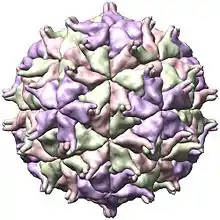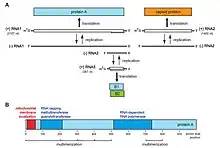Alphanodavirus
Alphanodavirus is a genus of non-enveloped positive-strand RNA viruses in the family Nodaviridae.[2] Insects, mammals, and fishes serve as natural hosts. Diseases associated with this genus include: Nodamura virus paralysis in infected wax moth larvae. Member viruses can also provoke paralysis and death to suckling mice and suckling hamsters. There are five species in this genus including the type species Nodamura virus.[3][4]
| Alphanodavirus | |
|---|---|
 | |
| Structure of Nodamura virus[1] | |
| Virus classification | |
| (unranked): | Virus |
| Realm: | Riboviria |
| Kingdom: | Orthornavirae |
| Phylum: | Kitrinoviricota |
| Class: | Magsaviricetes |
| Order: | Nodamuvirales |
| Family: | Nodaviridae |
| Genus: | Alphanodavirus |
| Type species | |
| Nodamura virus | |
Structure

Viruses in the genus Alphanodavirus are non-enveloped, with icosahedral geometries, and T=3 symmetry. The diameter is around 30 nm. Genomes are linear and segmented, bipartite, around 21.4kb in length.[3][4]
Life cycle
Viral replication is cytoplasmic. Entry into the host cell is achieved by penetration into the host cell. Replication follows the positive-strand RNA virus replication model. Positive-strand RNA virus transcription, using the internal initiation model of subgenomic RNA transcription is the method of transcription. Member viruses are released by lysis of the infected host cell. Insects, mammals, and fishes serve as the natural host.[3][4]
Taxonomy
The genus has five species:
- Black beetle virus
- Boolarra virus
- Flock House virus
- Nodamura virus
- Pariacoto virus
References
- "1NOV." RCSB PDB. N.p., n.d. Web. 10 Dec. 2015.
- Sahul Hameed, AS; Ninawe, AS; Nakai, T; Chi, SC; Johnson, KL; ICTV Report, Consortium (January 2019). "ICTV Virus Taxonomy Profile: Nodaviridae". The Journal of General Virology. 100 (1): 3–4. doi:10.1099/jgv.0.001170. PMID 30431412.
- "ICTV Report Nodaviridae".
- "Viral Zone". ExPASy. Retrieved 12 June 2015.